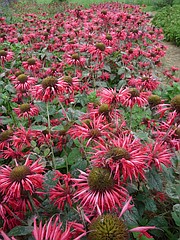Xeriscaping helps thwart dry summer heat
VALLE NOVAK Contributing Writer | Bonner County Daily Bee | UPDATED 2 years, 4 months AGO
Our North Idaho summers have become a beach-lover’s dream and a gardener’s nightmare with hot days and no rain for seemingly endless weeks. But don’t despair, all you green-thumbers, help is at hand!
The term xeriscape — common in Arizona and other desert realms — has become a new byword up in our Rocky Mountain stronghold, and it’s a lifesaver for ornamental gardeners, as well as corn and tomato growers.
I’ll admit, I never gave xeriscaping much thought, but in the past years of tending “my” roses in the Healing Garden next door to Bonner General Health, and watching landscaper Barbara Pressler at work in her dry habitat area (which is what xeriscape is), I have learned enough to present an article that may be of help for our newly hot summers.
Simply stated, one must plan a garden with plants that do not need or demand much water or sun protection. Or in other words, sun-loving plants.
Those of us who adore our cottage gardens with sweet shade and moisture loving bloomers, can of course, keep them in their protected (generally with shade trees) areas; but for the big picture, some new planning is called for.
The beauty of xeriscaping is that dramatic pairings are possible — bright flowers seem to love bright sun — and some of Barb’s creations can stand we neophytes in good stead. Witness her placement of rich blue-violet-spired Veronica against the bright brown/black-eyed yellow of Rudbekia, on the other side of which thrives a great stand of Echinacea (purple coneflower); talk about drama.
Think of the combinations this grouping suggests: Countless daisy/aster/sunflower “marriages” for our own gardens come to mind in lieu of these selections. Think Clara Curtis (pink), Michelmas (periwinkle), Shasta (white) daisies, or any number of yellow to gold Helianthus. Too, consider the graceful pastel loveliness of China asters or the brilliance of zinnias — both annuals, but so effective!
For the upright, “spired” complement, select liatris, celosia, astilbe — all available in a host of colors, or perhaps decide on a different “go-with” — campanulas, perhaps, the tall and sturdy but delicately rounded bellflowers in blue, pink or white: all are forgiving of hot, dry days.
A fabulous stand of magenta lobelia grows at the Healing Garden; proud and effective on its own, it could also pair with Tradescantia (spider lily), with its many-leaved airiness, clusters of light or dark blue flowers nestled within for a stunning combination.
Don’t overlook other “wild” pairings, like Goldenrod (Solidago) and red Oriental poppies or red/purple Monarda (bee balm) and silvery-grey Artemisia. The results can be truly stunning.
Interspersed shrubs are a given, and could include lavender, santolina (lavender cotton), Sage from ornamental Salvias to Clary sage (S. sclarea) and culinary strains; Baby’s breath, Potentilla, Corepsis, Nepeta, and a variety of Viburnums.
Oregon grape, prostrate juniper, and Mugho (and other dwarf) pines provide texture and contrast, as would a variety of ornamental grasses in clumps here and there (Miscanthus purpureus is a great and hardy area grower).
Groundcovers can vary from our native Kinnikinnick, Prunella (Self-heal) and Veronica, to Sedum, creeping and woolly thyme, creeping Veronica, Tanacetum, creeping phlox, and Portulaca (moss rose). Vinca minor (Periwinkle) grows in any location, staying green over winter, and makes a thick, beautiful cover. Sweet woodruff, too, with its fragrant whorled leaves and tiny white floral “bouquets” is another happy choice, as is Snow-on-the-Mountain (Cerastium).
We’ve only touched the tip of the iceberg (or sand dune), and many other choices are viable. Send for a copy of “High Country Gardens” catalog (look in the internet), which specializes in dry and hardy species that thrive in heat and even poor soil. Many of them are also deer-proof, a true bonus here. You’ll find that planning your new xeriscape garden will be more of a delight than a challenge.
(Editor’s note: For many years, Valle Novak has written gardening and cooking columns for the Daily Bee. “Weekend Gardener” and “Country Chef” became renowned for their humor, information and common sense advice on how to do everything from planting to cooking. While she recently retired, she has shared a number of columns to delight her many fans. This is one such column, originally published on Aug. 26, 2007.)








